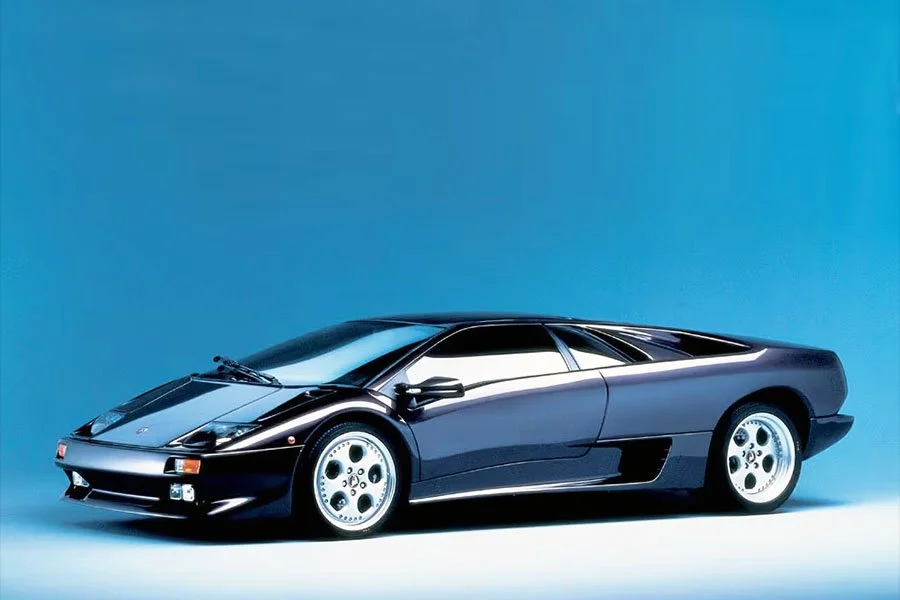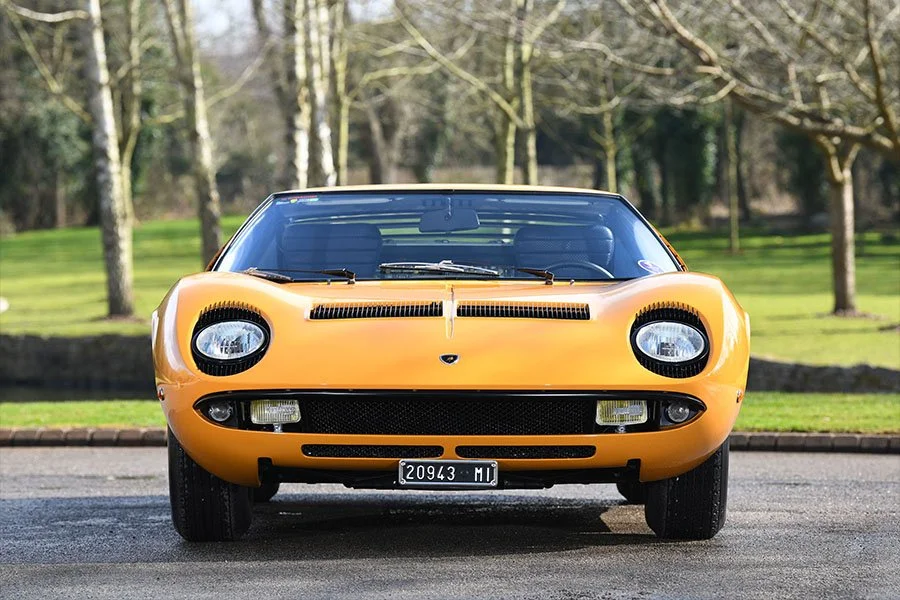Guide: Jota Lite - a Historical & Technical Appraisal of the Lamborghini Miura P400 SV/J
/BACKGROUND
Outside the world of politics, the Shah of Iran, Mohammad Pahlavi, was renowned as a lover of fine automobiles to include both those with a luxury and high performance nature.
Having received a Bugatti Type 57C Cabriolet as a wedding gift from the French government in 1939, the Shah’s interest in expensive motor cars really took off during the early 1950s. By this time, Iran’s oil fields were operating in full swing and Pahlavi had established himself as the Middle East’s pre-eminent leader.
Famously, after taking delivery of an early Maserati 3500 GT with which he was most pleased, a subsequent victory to the House of the Trident in late 1958 saw the Shah express an interest in purchasing a new Gran Turismo fitted with one of the firm’s venerable 450 S V8 racing engines.
Maserati obliged and, in October 1959, the Shah’s new dark blue 5000 GT was ready. A small number of highly individual coachbuilt copies were produced over the years that followed as the wickedly expensive 5000 GT came to be regarded as “the car of kings”.
Just over ten years later, the Shah’s motoring legacy was enhanced when, on a visit to the Lamborghini factory in Sant’Agata, he commissioned another machine that became a true automotive icon.
By the spring of 1971, the Shah had already purchased an Espada plus two Miuras and he was soon to take delivery of a new Miura SV. However, on this latest visit to the factory the Shah’s interest was piqued by a car he hadn’t previously known existed: the one-off Miura-based Jota.
Completed a few months prior, the Jota had pushed the Miura concept to it most extreme in order to serve as an experimental R&D test bed. Impressed by the Jota’s racey looks and optimised performance features, the Shah commissioned Lamborghini to build him a toned down replica suitable for road use.
The Shah’s spectacular Jota-inspired Miura was completed in December 1971 and the Miura SV/J was born.
Thanks to its array of customised details, most of which were very labour-intensive to create, the final price for the Shah’s SV/J came in at over 60% more than an otherwise standard SV. A handful of ‘official’ copies were subsequently assembled, but owing to the time consuming nature of each build along with the SV/J’s vast cost and what were quite depressed economic conditions, most Lamborghini customers opted for a regular SV.
CHASSIS
Each SV/J was based around a standard Miura SV steel monocoque chassis.
Compared to earlier Miura variants, the SV’s monocoque had been made even stiffer to further improve torsional rigidity. In addition, to accommodate the SV’s wider rear wheels and reduce oversteer, the rear suspension pick-up points had been relocated and new lower rear wishbones installed.
Like all Miuras, tubular steel subframes were attached at either end of the central tub to support the engine, gearbox, suspension and other ancillary equipment. Similarly, the wheelbase was an unchanged 2500mm. Chassis fabrication took place at Marchesi in Modena.
The suspension layout comprised double wishbones, coil springs and telescopic dampers. An anti-roll bar was fitted at either end. For the SV/J, the springs, dampers and anti-roll bars were stiffened up and ride height was slightly lowered.
Non servo-assisted ventilated Girling disc brakes ran off a separate hydraulic circuit for each axle. The front discs had a 305mm diameter while those at the rear measured 279mm.
Whereas earlier Miuras had used 7 x 15-inch Campagnolo centre-lock wheels; the SV and SV/J came with wider 9-inch wheels at the rear. All four corners got Pirelli’s latest tyre compound.
A 90-litre fuel tank was located over the front axle.
ENGINE / TRANSMISSION
For the SV, Lamborghini had developed a further uprated iteration of the Giotto Bizzarrini-designed 60° V12 with enlarged inlet ports and more radical cam timing.
This had resulted in a peak output of 385bhp at 7850rpm and 294lb-ft at 5750rpm compared to 370bhp at 7700rpm and 287lb-ft at 5500rpm for the outgoing Miura S.
The rest of the specification had remained unchanged: these engines featured an all-alloy construction with chain-driven dual overhead camshafts, single plug ignition with two coils and two Marelli distributors, wet-sump lubrication, 10.7:1 compression and four triple-choke downdraught Weber 40 IDL 3L carburettors.
Displacement was the familiar 3929cc thanks to a bore and stroke of 82mm and 62mm respectively.
In order to reflect the SV/J’s status as the ultimate Miura road car, some further modifications were deemed necessary.
With this in mind, blueprinted engines were assembled to the finest tolerances and fitted with larger, re-profiled inlet ports, polished connecting rods, a balanced competition-grade crankshaft, carburettors with competition-type trumpets, quickly detachable air filters and uprated fuel pumps. There was also a new straight-through megaphone exhaust system that exited through instead of underneath the tail fascia.
All told, peak output was around 415bhp.
As usual, transmission was through a five-speed Lamborghini transaxle with a single-plate clutch and open differential.
BODYWORK
In addition to the SV/J’s more raucous engine, what really stood these cars apart from a regular Miura SV was the array of Jota-inspired cosmetic enhancements.
To begin with, standard SV panels were delivered from Bertone to Lamborghini where they were modified to SV/J trim.
Perhaps most obvious of the myriad new SV/J details was the switch from standard retractable headlights to fixed units mounted underneath contoured Plexiglas covers. In between, the familiar slatted radiator cooling grilles were discarded in favour of simple meshed wire installations. Above, Lamborghini added a competition-style external fuel filler cap.
Lower down, the Miura’s full width front intake aperture was kitted out with a simplified SV/J-specific front bumper. Underneath were larger, more powerful driving lights and re-shaped indicators, both of which were housed behind new Plexiglas covers.
Whereas the Jota had featured enormous downforce-inducing canards at each front corner, the SV/J was kitted out with a more discrete full width chin spoiler.
Along each flank, channelled cutaways were added behind all four wheels (meshed on the rear) to relieve pressure in the wheel wells and assist brake cooling.
At the back of the SV/J, a pair of meshed rectangular vents were located between the tail lights which required a modified luggage compartment. The Miura’s familiar hex-pattern grille was deleted.
Another trademark SV/J feature was the exposed riveting found around the upper front lid radiator vents, the cutaways for the exposed fuel filler cap and the fender / tail fascia vents.
INTERIOR
Aside from coming with the normally optional full leather upholstery as standard, the SV/J cockpit was unchanged.
Directly behind the leather-rimmed three-spoke steering wheel was a 320kmh speedometer and a 10,000rpm rev counter. Each dial was housed in its own individual cowl.
The rest of the instrumentation was located in an arced centre console that swept down to join the transmission tunnel. The half dozen additional gauges were stacked in two horizontal banks of three. Read outs for water temperature, oil temperature, oil pressure, fuel and battery condition were provided along with a clock.
Switchgear was mounted on the centre console and a roof-mounted tunnel.
Electric windows were fitted as standard.
Fixed-back bucket seats were only adjustable fore / aft.
OPTIONS
Given the SV/J’s enormous price and the VIP nature of its purchasers, Lamborghini were happy to try and satisfy any special requirement.
With this in mind, some cars came with an uprated oil cooler, a long-range 110-litre fuel tank (which meant there was no longer space for a spare wheel), a limited-slip differential and the same split-sump option offered on the SV that saw the engine and gearbox oil separated to avoid the bearing damage that some earlier Miuras had suffered as a result of consistently hard driving.
Other variations included hexagonal hub nuts instead of conventional triple-eared spinners, dual windscreen wipers instead of a single panoramic item, even more powerful lights, re-installation of a modified hex-pattern tail fascia grille, passenger-side exterior mirror delete, four-point harnesses, a fire extinguisher and a set of Heuer rally clocks.
WEIGHT / PERFORMANCE
Owing to the absence of heavy retractable headlight mechanisms and exhaust silencers plus the odd additional piece of trim, the SV/J probably weighed in around 15kg less than a standard Miura (1278kg as opposed to 1293kg).
Top speed was likely 185mph (up from 180mph) while the 0-62mph time would have been a tenth or two quicker (5.5/5.6 seconds down from 5.7).
PRODUCTION CHANGES
Following completion of the Shah of Iran’s SV/J, Lamborghini added exposed rivets to the trailing edge of front clamshell, the leading edge of the rear clamshell and around the trunk lid perimeter.
Enlarged tail fascia vents were also introduced and some cars got a Jota badge.
PRODUCTION
Four ‘official’ examples of the SV/J were completed by Lamborghini between December 1971 and April 1973.
The first SV/J was chassis 4934 completed in December 1971 for the Shah of Iran.
The second SV/J was chassis 4990 completed in April 1972 for Albert Silvera.
The third SV/J was chassis 5090 completed in August 1972 for Paul Ferrandi.
The fourth SV/J was chassis 4860 converted in April 1973 for Hubert Hahne.
In 1974, Lamborghini confirmed the existence of a fifth SV/J, chassis 4892, but the precise date of this car’s conversion to SV/J trim was not recorded.
PATRICK MIMRAM SV/J
In 1986 Lamborghini created an SV/J-inspired Miura for Patrick Mimram who, along with his brother Jean-Claude, were the owners of Automobili Lamborghini SpA having rescued the company from administration in July 1980.
Patrick Mimram’s SV/J was converted from chassis 4088 (originally completed as a Miura S in May 1968).
Text copyright: Supercar Nostalgia
Photo copyright: Lamborghini - https://www.lamborghini.com & RM Sotheby’s - https://rmsothebys.com/




































